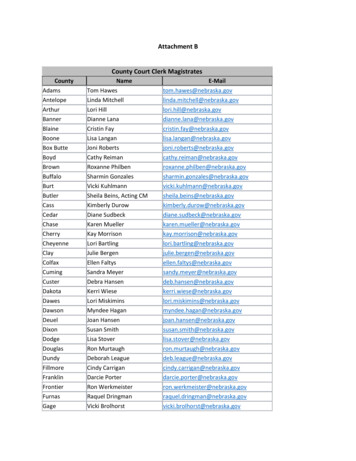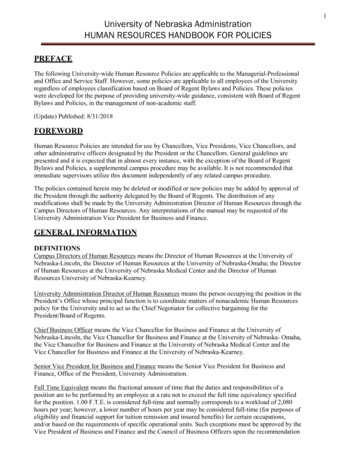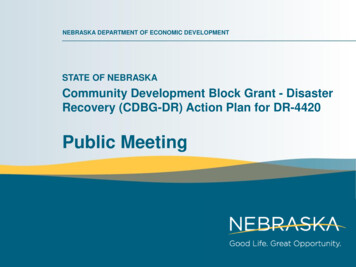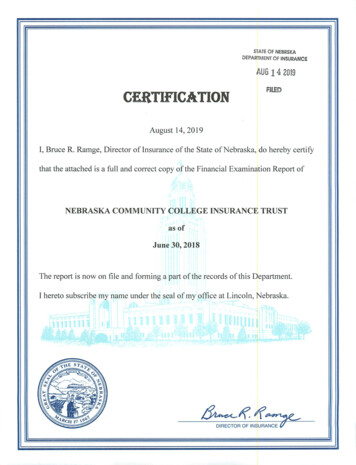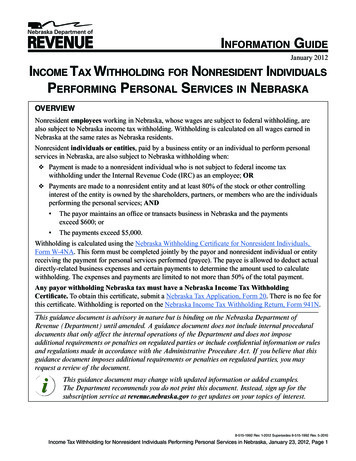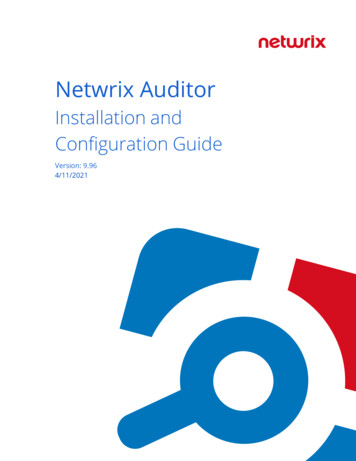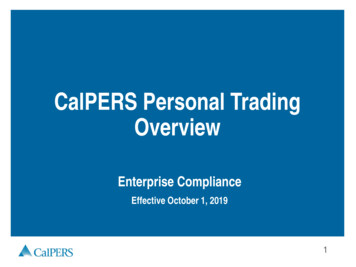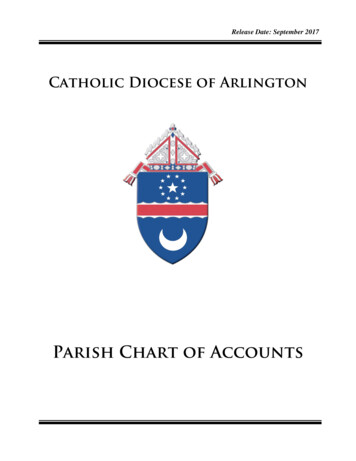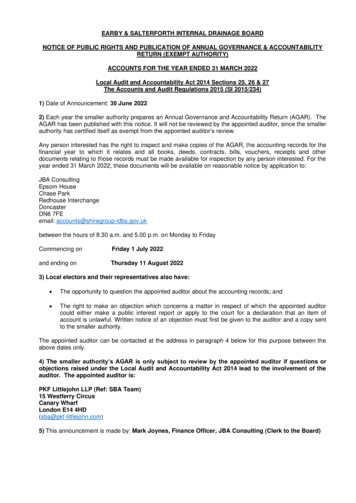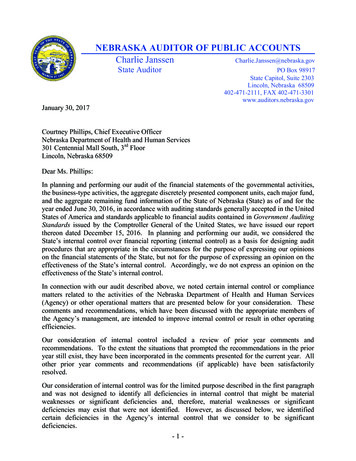
Transcription
NEBRASKA AUDITOR OF PUBLIC ACCOUNTSCharlie JanssenCharlie.Janssen@nebraska.govState AuditorJanuary 30, 2017PO Box 98917State Capitol, Suite 2303Lincoln, Nebraska 68509402-471-2111, FAX 402-471-3301www.auditors.nebraska.govCourtney Phillips, Chief Executive OfficerNebraska Department of Health and Human Services301 Centennial Mall South, 3rd FloorLincoln, Nebraska 68509Dear Ms. Phillips:In planning and performing our audit of the financial statements of the governmental activities,the business-type activities, the aggregate discretely presented component units, each major fund,and the aggregate remaining fund information of the State of Nebraska (State) as of and for theyear ended June 30, 2016, in accordance with auditing standards generally accepted in the UnitedStates of America and standards applicable to financial audits contained in Government AuditingStandards issued by the Comptroller General of the United States, we have issued our reportthereon dated December 15, 2016. In planning and performing our audit, we considered theState’s internal control over financial reporting (internal control) as a basis for designing auditprocedures that are appropriate in the circumstances for the purpose of expressing our opinionson the financial statements of the State, but not for the purpose of expressing an opinion on theeffectiveness of the State’s internal control. Accordingly, we do not express an opinion on theeffectiveness of the State’s internal control.In connection with our audit described above, we noted certain internal control or compliancematters related to the activities of the Nebraska Department of Health and Human Services(Agency) or other operational matters that are presented below for your consideration. Thesecomments and recommendations, which have been discussed with the appropriate members ofthe Agency’s management, are intended to improve internal control or result in other operatingefficiencies.Our consideration of internal control included a review of prior year comments andrecommendations. To the extent the situations that prompted the recommendations in the prioryear still exist, they have been incorporated in the comments presented for the current year. Allother prior year comments and recommendations (if applicable) have been satisfactorilyresolved.Our consideration of internal control was for the limited purpose described in the first paragraphand was not designed to identify all deficiencies in internal control that might be materialweaknesses or significant deficiencies and, therefore, material weaknesses or significantdeficiencies may exist that were not identified. However, as discussed below, we identifiedcertain deficiencies in the Agency’s internal control that we consider to be significantdeficiencies.-1-
A deficiency in internal control exists when the design or operation of a control does not allowmanagement or employees, in the normal course of performing their assigned functions, toprevent, or detect and correct misstatements on a timely basis. A material weakness is adeficiency, or a combination of deficiencies in internal control, such that there is a reasonablepossibility that a material misstatement of the entity’s financial statements will not be prevented,or detected and corrected, on a timely basis. We did not identify any deficiencies in internalcontrol that we consider to be material weaknesses.A significant deficiency is a deficiency, or combination of deficiencies, in internal control that isless severe than a material weakness, yet important enough to merit attention by those chargedwith governance. We consider Comment Number 1 (Material Adjustments), Comment Number2 (Medicare Part D), Comment Number 3 (Overpayment Mailbox), Comment Number 4(Overpayments), and Comment Number 5 (External MMIS User Access) to be significantdeficiencies.Those comments will also be reported in the State of Nebraska’s Statewide Single Audit ReportSchedule of Findings and Questioned Costs.In addition, we noted other matters involving internal control and its operation that we havereported to management of the Agency, pursuant to AICPA Auditing Standards AU-C Section265.A17, in separate early communication letters dated September 7, 2016, andSeptember 28, 2016.Draft copies of this letter were furnished to the Agency to provide management with anopportunity to review and to respond to the comments and recommendations contained herein.All formal responses received have been incorporated into this letter. Responses have beenobjectively evaluated and recognized, as appropriate, in the letter. Responses that indicatecorrective action has been taken were not verified at this time, but they will be verified in thenext audit.The following are our comments and recommendations for the year ended June 30, 2016.1.Material AdjustmentsThe Department of Administrative Services, State Accounting Division (DAS), prepares theState of Nebraska Comprehensive Annual Financial Report (CAFR) and requires all Stateagencies to determine and report accurate amounts for financial reporting.The Agency indicated in its response to the Summary Schedule of Prior Audit Findings that itscorrective action plan was complete regarding errors in accrual information. However,throughout testing, we noted the following items were not accurately reported to DAS: The Agency understated short-term payables by 2,051,744 related to the IndirectMedical Education (IME) and Direct Medical Education (DME) payments owed atJune 30, 2016, but not yet paid to providers. When compiling the accrual response form,prior year figures were used instead of developing reasonable estimates based onhistorical and available data. The Auditor of Public Account’s (APA’s) proposedadjustment was made by DAS to correct the error. An additional amount of 871,858 ofIME and DME long-term payables was determined to be understated for similar issues;no adjustment was proposed or made for this amount.-2-
The State Ward payable was overstated by 1,404,773. The amount was coded withinthe State accounting system as a payable at June 30, 2016, and the Agency included theamount on the accrual response form, resulting in it being counted twice. The APA’sproposed adjustment was made by DAS to correct the error. The Medicaid, State Disability, and Children’s Health Insurance Program (CHIP) payablewas overstated by 2,600,000, as an adjustment was counted twice. The APA’s proposedadjustment was made by DAS to correct the error. The Third Party Liability (TPL) receivable is for balances due from legal obligations ofthird parties (i.e., individuals, insurers, program, etc.). The Agency calculated thereceivable by averaging total amounts recovered over the past eight years, representingthe amount expected to be recovered during an entire fiscal year. The Agency estimatedthat only recoveries made within the first 45 days of the following fiscal year would havebeen submitted for collection prior to fiscal year end and considered receivable atJune 30, 2016. Using this criteria as a guide, the APA calculated an overstatement of theTPL receivable to be 6,949,955. The APA’s proposed adjustment was made by DAS tocorrect the error. The Medicaid Drug Rebate (MDR) program accounts receivable was overstated by 7,612,893, due to rebate checks on hand at the Agency that had not been recorded in theState’s accounting system or the MDR system. The APA’s proposed adjustment wasmade by DAS to correct the error. An additional amount of 264,418 was determined tobe overstated due to mathematical errors and figures not updated from the previous yearwhen calculating the receivable balance; no adjustment was proposed or made for thisamount. The patient and county billings receivable was overstated by 233,240, as accountbalances approved for write-off by the State Claims Board were not removed. Anadditional amount of 19,334 was determined to be overstated, as 5 of 25 patientbalances tested were not pursued by the Agency for collection or written-off in a timelymanner. No adjustments were proposed or made for these immaterial amounts. Four ofthose five balances were inaccurately reported as receivables. A 3,031,549 journal entry was made in fiscal year 2016 to correct a duplicate entrymade in fiscal year 2015. The entry was not properly recorded as a prior periodadjustment, resulting in an overstatement of current year Federal fund expenditures andan understatement of General fund expenditures. DAS passed on the APA’s proposedadjustment. On a quarterly basis, costs associated with printing and producing occupational licensesare allocated to various programs. The entry used to allocate expenditures incorrectlyused transfer in/out account codes, which resulted in revenues and expenditures beingoverstated by 789,562. The APA’s proposed adjustment was made by DAS to correctthe error. Cash was overstated by 1,298,169, as a disbursement from the State Ward ChildSupport account on June 3, 2016, was not included in fiscal year 2016 bank activity. TheAPA’s proposed adjustment was made by DAS to correct the error.A similar finding was noted during the previous audit.-3-
Title 2 CFR part 200.511(a) (January 2016), requires the auditee to prepare a summary scheduleof prior audit findings. Per subsection (b)(2) of that same regulation, “When audit findings werenot corrected or were only partially corrected, the summary schedule must describe the reasonsfor the finding’s recurrence and planned corrective action, and any partial corrective actiontaken.”A good internal control plan requires agencies to have procedures for the reporting of accurateand complete financial information to DAS.Without adequate processes and procedures in place to ensure the accuracy of financialreporting, there is a greater risk material misstatements may occur and remain undetected.We recommend the Agency implement procedures to ensureinformation is complete and accurate. The Agency should alsohave adequate procedures in place for a secondary review to verifythe information is supported, reasonable, and accurate.Agency Response: The Agency agrees with the condition reported.Corrective Action Plan: Since the issuance of the 2013 Single Audit, the Agency hasimplemented several improvements to the CAFR accrual reporting process that has resulted infewer errors in recent Single Audits. Financial Services staff in cooperation with Internal Audithosts an annual CAFR kick-off meeting with all staff involved in the reporting process andincludes DAS Accounting in these meetings. This meeting outlines the internal reportingprocess, documentation expectations, prior year audit findings and deadlines. Documentationfor each accrual item is then collected and compiled by Financial Services based on a predefined and communicated deadline for an initial review and then is subsequently reviewed byInternal Audit staff.The IME/DME accrual calculation was new to the 2015 and 2016 CAFR and had no adjustmentsnoted during the 2015 CAFR. The audit adjustment for 2016 was due to the fact thatdocumented procedures, while adhered to, relied on using prior year long-term payablecalculations as a basis for current year short-term payable calculations. Procedures will bemodified to include an annual recalculation of estimates.The adjustment for TPL was due to the fact that the Agency modified its procedures forcalculating this particular receivable. The Agency proposed a change in reporting to improveaccuracy which was agreed to by DAS. It was discovered during the audit that the Healthportion of this receivable was overstated due to the fact that Health claims receivable turnover ismuch higher than the casualty and should have been limited to those only claims submittedwithin 45 days prior to the end of the fiscal year.The majority of the MDR receivable overstatement was due to the rebate checks on hand but notyet processed. Currently all of these checks have now been processed and the Agency hasrevised internal procedures to ensure timely processing of these rebate checks.The cash overstatement was due to a transfer of funds from an external bank account into theState’s banking system while working with the State Treasurer’s Office to addresscollateralization issues. This amount was not removed from the accrual response form to DAS.-4-
2.Medicare Part DThe Lincoln Regional Center (LRC) claims for Medicare Part D (Medicare Prescription DrugCoverage) have not been billed to the responsible parties since November 2013. According tothe Agency, there were balances totaling 2,261,151, as of June 30, 2016, which are anticipatedto be unrecoverable due to the passing of the maximum allowable time to recover lost revenues.According to the Agency, various issues with the vendor’s system and contract procurementprocess had prevented the Agency from pursuing reimbursement for Medicare Part D sinceNovember 2013. The APA had a finding regarding this issue in the prior audit.A similar finding was noted during the previous audit.Sound accounting practices and good internal controls require policies and procedures to pursueand resolve issues related to receivable balances.When receivables are not billed for an extended amount of time, there is an increased risk for theloss of State funds due to the inability of DHHS to bill for reimbursement based on timerestrictions.We recommend the Agency work to resolve their billing issues, soMedicare Part D claims can be submitted and reimbursed to theState.Agency Response: The Agency agrees with the condition reported.Corrective Action Plan: As indicated during the review, Lincoln Regional Center (LRC) isactively working to resolve the contractual and software problems that have impeded billingresponsible parties for Medicaid Part D claims since 2013. While software issues and contractswith intermediaries were being resolved, paper billings were not permissible by Medicare. SinceApril, 2016, Agency Legal and LRC staff have worked with the Center for Medicare Services(CMS) Intermediaries to reinstate the required contracts. At the same time, the vendor hasworked to resolve software issues impeding the billing process. As of this response, ongoingbilling is occurring with two intermediaries, a third intermediary contract has been signed by theAgency and is waiting the intermediary signature, and the remaining intermediary contracts arein process. Active billing for Medicare Part D claims is being conducted with the intermediariesas contracts are finalized and subsequently allowed. Recovery of prior billings is limited to sixtydays.3.Overpayment MailboxOn November 30, 2011, the Agency set up the Overpayment Mailbox (Mailbox) for eligibilityoverpayments. Previously, Social Service Workers (SSWs) would set up overpayments andunderpayments in the Nebraska Family Online Client User System (NFOCUS) as theydiscovered them. Eligibility overpayments were referred via email to the Mailbox to be workedby an Overpayment (OP) Unit team.-5-
In the prior audit, we noted 12,525 referrals were unworked. The situation has not changedsignificantly – the figure as of June 30, 2016, was 11,580 unworked referrals. However, theAgency also had 5,687 unworked referrals labeled as “Non Pursuable,” of which 5,413 wereSupplemental Nutrition Assistance Program (SNAP) errors made by the Agency. This brings thetotal of unworked referrals to 17,267.The Agency indicated the referrals were not pursuable because they were over 12 months old,which is in accordance with the Agency’s regulations at 469 NAC 3-007.03B2 and 475 NAC 4007.01A. Per 475 NAC 4-007.01A, “Overpayments must be established against households whowere issued benefits they were not entitled to receive due to an AE [Administrative Error] for nomore than 12 months before the month of initial discovery.” However, this State regulationconflicts with 7 CFR § 273.18(c)(1), which requires the agency to “calculate a claim back to atleast twelve months prior to when you became aware of the overpayment.” (Emphasis added.)Even if the Federal regulations did not exist, common sense and good internal control wouldsuggest the original intent of the State regulations was not to allow the Agency to sit onoverpayment referrals until they are over 12 months old, and then discard them.We also noted that using the Outlook email account increases the risk that referrals will beinappropriately deleted.SNAP regulation 7 CFR § 273.18(d)(1) (January 1, 2016) requires the State to “establish a claimbefore the last day of the quarter following the quarter in which the overpayment or traffickingincident was discovered.” The Agency follows this timeframe for all programs. A good internalcontrol plan requires procedures to be in place to ensure overpayments are established inNFOCUS in a timely manner.Without adequate controls and resources to work suspected overpayments, timeframes set byFederal regulations may not be met. Overpayments not worked timely have a lesser chance ofcollection. Overpayments not worked at all will have no chance of collection. There is lessincentive for the Agency to pursue collection on SNAP AE overpayments, as the Federalgovernment requires all of those collections to be returned in their entirety to the Federalgovernment. However, those overpayments increase the taxpayer burden at the Federal level,and the Agency should actively pursue those receivables. Considering the number of referralsnot worked, there are potentially millions of dollars in overpayments that the Agency has notattempted to recover.We recommend the Agency implement procedures and devoteadequate resources to investigating and establishing NFOCUSreceivables. If the Agency continues to use the Mailbox foreligibility overpayments, care should be taken to ensure all emailsare properly tracked, monitored, and maintained. We recommendthe Agency define the date of discovery as the date the regularSSW first becomes aware of a potential overpayment. The Agencyshould comply with Federal regulations. We also recommend theAgency implement procedures to reduce the number of SNAP AEoverpayments.-6-
Agency Response: The Agency agrees with the condition reported.Corrective Action Plan: The Agency created an overpayment team with primary responsibilityfor working overpayment referrals and secondary responsibility as backup for AccessNebraska.Access to the overpayment mailbox has been limited to only staff with a business requirement.Currently referrals are received at a rate of 150 per week and current procedures and resourcesallow for 50 referrals per week to be completed.The Agency will begin a more in-depth review of the current referral process as well as the stepsand procedures for reviewing and establishing an overpayment for operational efficiencies.Additionally, the Agency is reviewing the feasibility of utilizing an Access database to storereferrals as a replacement of the Outlook Mailbox for enhanced controls.The Agency will modify procedures and communicate to relevant staff of the federal timelinerequirements for establishing overpayments.4.OverpaymentsDuring testing of nine accounts receivable from NFOCUS, we noted various errors, as describedbelow.Receivables Not Set Up TimelyFour of six accounts receivable tested were set up after the calendar quarter, following the dateof discovery. The receivables were set up 156, 152, 125, and 69 days late.Per 7 CFR § 273.18(d)(1) (January 1, 2016), a State must “establish a claim before the last dayof the quarter following the quarter in which the overpayment of trafficking incident wasdiscovered.”Collection Policy Not FollowedThe Agency’s own Collection Policy was not followed for three of nine receivable accountstested. One receivable balance was suspended because the Agency was unable to locate theprovider. When a receivable is suspended, no collections efforts are performed. The provider’saddress was later updated when the provider applied for, and received assistance for, otherNFOCUS programs; however, the account remained suspended. For the second account tested,the procedure for accounts 90 days overdue was not followed, as a director letter was not sent tothe provider. For the third account, the first billing statement was sent two months late, and thedirector and legal letters were not sent.Good internal control requires the Agency’s Collection Policy and payment agreements to befollowed. The Agency’s Collection Policy states, in part, the following:(2) DHHS will send regular billing statements for all accounts receivable, except when prohibited by law.(3) [F]or accounts which are 90 days overdue, unless suitable arrangements have been made for payment:a. DHHS will send the Debtor a letter, signed by the appropriate Director, requesting payment.b. If no response is received within 30 days of the initial letter, DHHS will send the Debtor a secondletter, signed by a DHHS Legal and Regulatory Services (LRS) attorney, again requesting payment.-7-
c. If no response is received within 30 days of the second letter, DHHS will take .action, based onthe dollar value of the account.(6) Except in situations where collection efforts are required by law, DHHS will suspend collection efforts,with the exception of monthly billing statements, during any period that the Debtor is receiving state orfederal needs-based assistance, whether or not the statute of limitations may expire prior to the terminationof the needs-based assistance.Missed RecoupmentsFor two accounts receivable tested, the providers were receiving payments in NFOCUS. Assuch, a portion of the provider payments should have been recouped and applied towards thereceivable balances. For one account, potential recoupments totaling 235 were missed duringthe fiscal year. For the other account, five months of recoupments, totaling 50, were missed.Per Title 475 NAC 4-007.02A, related to SNAP, “Collection on Accounts Receivable will bedone through recoupment from the household’s benefit or by other collection actions.”Per Title 392 NAC 5-005, related to Child Care, “If the provider does not appeal or contact theDepartment to work out a repayment agreement, the overpayment will be recouped from futurebillings for the same or different children, or from another service.”Receivable MishandledA beginning receivable balance of 258 was overstated by 109. In an attempt to correct thebalance, the Agency created a second receivable balance for the correct amount of 149;however, the incorrect balance of 258 was not removed.A similar finding was noted during the previous audit.A good internal control plan and sound business practices require procedures to ensurereceivable balances are accurate.Inadequate controls and procedures result in fewer collections of Federal and State funds thatcould be used to reduce the taxpayer burden.We recommend the Agency implement controls and procedures toensure policies are followed. The Agency should review itscollection policy and consider automating more collectionprocesses in NFOCUS.Agency Response: The Agency agrees with the condition reported.Corrective Action Plan: The Agency implemented new standard operating procedures and a newsystem using Microsoft SharePoint to ensure that all receivables for provider overpayments areset up timely, improve monitoring and reporting, and reduce the error risk. The new proceduresinclude random quality verification to self-audit for accuracy as well as a weekly review ofnewly activated clients and providers who have an open account receivable.A revised Collection Policy has been drafted and is currently in management review whichincludes several internal procedural changes to ensure adherence to policy requirements.-8-
5.External MMIS User AccessThe Medicaid Management Information System (MMIS) supports the operations of the MedicaidProgram. The objective of MMIS is to improve and expedite claims processing, efficientlycontrol program costs, effectively increase the quality of services, and examine cases ofsuspected program abuse.In our review of access to MMIS, we noted that 402 of 919 external users tested at 9 externalentities were no longer current and active employees of the external entity or no longer neededaccess to MMIS. For one other external entity, we were not able to verify that the 47 users werecurrent and active employees of the external entity and required access to MMIS.The APA requested contact information for 10 of 836 external entities for MMIS to determine ifusers were still active employees and needed access to perform their job duties. The entitiesselected and the results of this inquiry were as follows:MMIS External EntitiesEntityAegis Sciences CorporationAmeriHealth Nebraska Inc.Boys TownFallbrook Family Health CenterKohls Pharmacy and HomecareMagellanNE Methodist Health SystemOne World Community Health CenterThayer County Health rs203641212182521489318919% Not 8%50.0%43.7%The APA also selected Children’s Hospital Colorado but was unable to verify that the users werestill active employees who needed MMIS access to perform their job duties.A similar finding was noted during the previous audit.The Nebraska Information Technology Commission (NITC) Standards and Guidelines,Information Security Policy 8-101 (December 2013), Section 4.7.2, User Account Management,states the following, in relevant part:A user account management process will be established and documented to identify all functions of useraccount management, to include the creation, distribution, modification and deletion of user accounts.Data owner(s) are responsible for determining who should have access to information and the appropriateaccess privileges (read, write, delete, etc.). The “Principle of Least Privilege” should be used to ensurethat only authorized individuals have access to applications and information and that these users only haveaccess to the resources required for the normal performance of their job responsibilities . . . .Agencies or data owner(s) should perform annual user reviews of access and appropriate privileges.A good internal control plan requires terminated users’ access to be removed timely.The external entities did not inform the Agency timely when employees were terminated. TheAgency performs a review of external users’ access only once a year.-9-
Failure to terminate former user access to networks and applications creates the opportunity forunauthorized access to Federally protected State data.We recommend the Agency improve procedures by performingmore routine reviews of external users’ access in order to ensureunauthorized access is removed in a timely manner. We alsorecommend the Agency periodically inform external entities of theimportance of notifying the Agency to remove employee accessupon termination.Agency Response: The Agency agrees with the condition reported.Corrective Action Plan: Recently the EDI Help Desk has coordinated with MMIS to enhanceseveral processes as well as identify and remove users that no longer require access. Theseenhancements decreased the amount of time to process enrollments for external users by movingthe external user data from an Excel spreadsheet to an Access database as well as a systemchange implemented in October 2016 for the user account management process.EDI has improved the timeframe for disenrollment of External MMIS Users without a need foraccess by streamlining the process for external user verification and implementing a process forprovider outreach. Additionally the Agency implemented improved standards to enhance theprocess of monitoring provider response to verification outreach. These processes includerequiring a detailed response regarding all enrolled individuals, and dis-enrolling nonresponsive providers within a designated time period. When verification is requested, providersare reminded of the importance of notifying the Agency to remove access to External MMISUsers upon their termination. The notification highlights the requirement of External Users tonotify the EDI Help Desk of any staffing changes or separations of individuals that haveExternal MMIS User Access. These improvements have enabled the EDI Help Desk tosuccessfully complete verification of 78% of all External Access Users over the course of 2016.The EDI Help Desk has also shortened the designated time period allotted to providers to replyto verification requests.6.Unauthorized Accounts Utilizing State’s Federal Tax Identification Number (FTIN)During the prior year audit, the APA identified a bank account that was using the State’s FTIN;however, the account was not authorized by the State Treasurer to do so. The account was stillusing the State’s FTIN and had not been authorized by the State Treasurer as of June 30, 2016.AgencyDHHSBank NamePinnacle BankAccount Name or OwnerDHHS – Bridges Program ResidentsAccountNumberXXX252Balance at6/30/2015 377.00A similar finding was noted in the previous audit.Neb. Rev. Stat. § 77-2301(1) (Reissue 2009) requires the following:The State Treasurer shall deposit, and at all times keep on deposit for safekeeping, in the state or nationalbanks, or some of them doing business in this state and of approved standing and responsibility, the amountof money in his or her hands belonging to the several current funds in the state treasury. Any bank mayapply for the privilege of keeping on deposit such funds or some part thereof.- 10 -
Neb. Rev. Stat. § 77-2309 (Reissue 2009) requires the following:It is made the duty of the State Treasurer to use all reasonable and proper means to secure to the state thebest terms for the depositing of the money belonging to the state, consistent with the safekeeping andprompt payment of the funds of the state when demanded.Neb. Rev. Stat. § 77-2398(1) (Cum. Supp. 2016) requires public funds in financial institutions tobe secured by the a
- 1 - NEBRASKA AUDITOR OF PUBLIC ACCOUNTS Charlie Janssen Charlie.Janssen@nebraska.gov. State Auditor . PO Box 98917. State Capitol, Suite 2303 . Lincoln, Nebraska 68509 . 402-471-2111, FAX 402-471-3301
